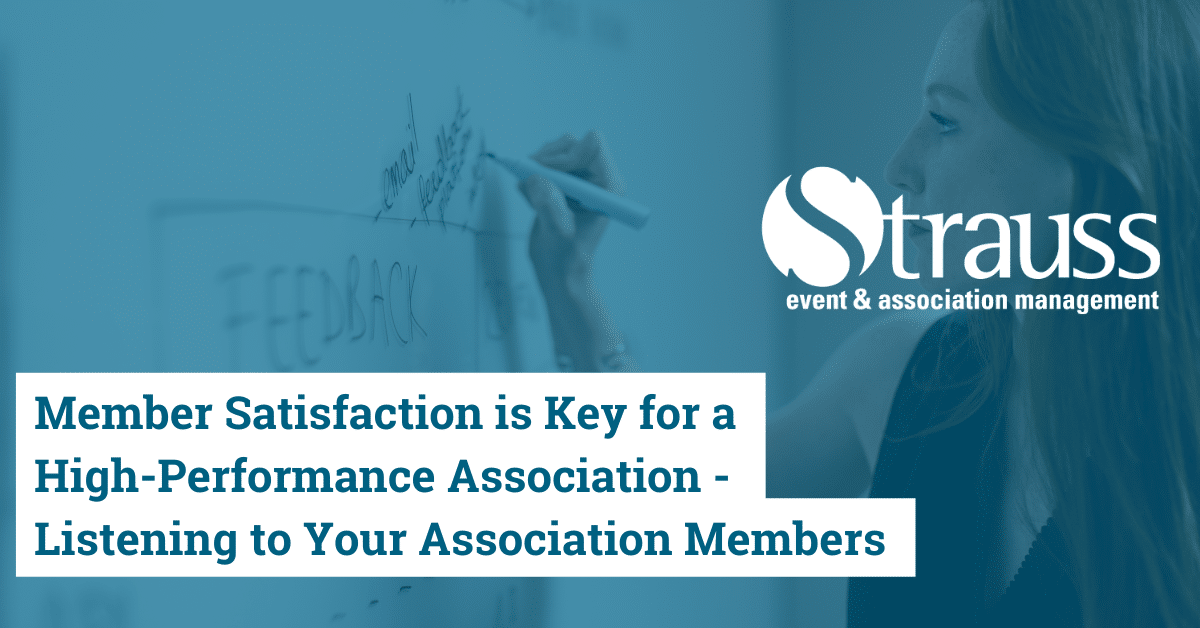One of the biggest traits of a high-performing association is member satisfaction! But how do you quantify and obtain member satisfaction, ensuring all are satisfied with their investment in the association and that their opinions are of value? (See one of my past articles highlighting the characteristics of a high-performance association: https://strauss.ca/association-high-performance-association/)
There are a few options to achieve this, including:
- Member Satisfaction Surveys
Several associations distribute member quantitative membership surveys annually, which provide valuable feedback. However, not everyone replies to these surveys.
(For additional information on member satisfaction research, see my original article: Research in Association Management (https://strauss.ca/research-in-association-management/)
- Focus Groups or one-on-one meetings
Members can also participate in focus groups or one-on-one meetings with the association’s leadership to answer key questions on performance – again, here, you may not reach the entire membership. Not everyone will have the time to participate.
- Members who choose to provide feedback throughout the year
Of course, you have the members who provide feedback and input throughout the year. (Member feedback is valuable, but it is also important to manage expectations on the association’s priorities for all members and how feedback can be woven effectively into updating or creating new initiatives to increase member satisfaction.
The biggest challenge for association leaders: How to engage those members who have gone radio silent? And most importantly, how do we promote to members the hard work, commitment and achievements the association’s leadership and staff have accomplished to date.
Two of the associations I manage have adopted Town Hall or “Ask the Board Anything” sessions and applied them to their annual General Meeting or annual conference. It is a fantastic opportunity for all members to participate and hear where other members find value in the association. We should always provide members with the opportunity to meet the association’s leadership and learn the hard work the volunteers and staff put into making this a high-performing association.
The association’s leadership should not view this event as negative, where members may complain about the performance of the board volunteers or staff. (The association’s leadership should view these Town Hall or “Ask the Board Anything” meetings for members as an excellent opportunity for face time with members to generate momentum for the association, highlight milestones, share future plans and connect members for a more cohesive and stronger association.
Typically, the only event where members get together is the annual general meeting (AGM). The AGM is a review of the previous year’s business and is not the avenue to discuss the future. Adding a Town Hall or Question and Answer Session is a great way to discuss the future goals of the association, secure member feedback, and how the leadership team is striving to achieve these goals.
Town Hall or Question and Answer Session: How does your association effectively pull this off?
- Make members aware of the session in advance:
Positively promote the session by highlighting the goals of the meeting through an agenda. Goals should include answering questions of the membership, highlighting the future activities and providing the opportunity for the membership to see the leadership in action.
- Outline a Code of Conduct for the meetings:
Along with the agenda, share a brief note requesting that all attending members adhere to the Code of Conduct by behaving respectfully with each other and the profession.
- Ask for questions in advance.
Questions can be put on the screen for all attendees to see, and the leadership can prepare a clear and concise answer.
- Allow each participant a maximum number of questions
Some members are more vocal than the others; we need to ensure a shared floor is available for all to get their questions in by limiting the number of questions per member. It’s OK to take some of the questions that require a bigger discussion offline with some members.
- Be prepared for the hard questions.
Sometimes, members can get passionate about a particular issue. If a question is offensive, hostile, or inappropriate, you have every right to decide not to answer this question. The session facilitator can ask that this attendee either re-phrase their question or arrange a time to meet with the leadership to discuss at a different time.
- Ensure this session has a defined length and is communicated in advance.
This session should have a clearly identified time length via an agenda (see the note above)
- Answer all remaining questions in writing to all members of the association
Advise all attendees that their questions are appreciated and valued. For those not addressed, due to time constrictions, the association leadership will follow up in writing and distribute the Q&A to all association members.
Combining various tools to listen to the association membership, share the organization’s goals and create two-way communication opportunities will provide an outstanding return on investment to the membership. Members and association leaders must understand points of view, address issues, and collectively meet the association’s targets.

